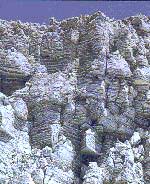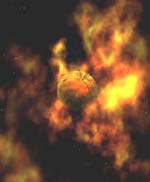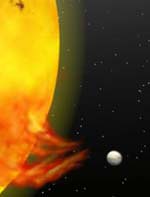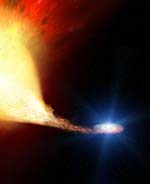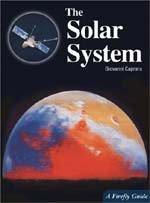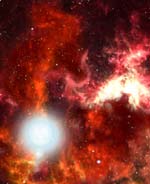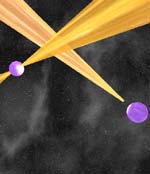
Image credit: RAS
An international team of astronomers have discovered a double pulsar system – the first ever seen. The two objects orbit a common centre of gravity once every 2.4 hours; one rotates at 3000 times a minute, while the other spins at only 22 times a minute. This discovery is important because it will allow astronomers to test various theories of relativity as the two objects interact with each other. The two pulsars will probably merge to become a black hole in 85 million years.
An international team of scientists from the UK, Australia, Italy and the USA have announced in today’s issue of the journal Science Express [ 8th January 2004 ] the first discovery of a double pulsar system.
They have shown that the compact object orbiting the 23-millisecond pulsar PSR J0737-3039A with a period of just 2.4 hours is not only, as suspected, another neutron star but is also a detectable pulsar, PSR J0737-3039B, that is rotating once every 2.8 seconds.
Professor Andrew Lyne of the University of Manchester points out that “While experiments on one pulsar in such an extreme system as this are exciting enough, the discovery of two pulsars orbiting one another opens up new precision tests of general relativity and the probing of pulsar magnetospheres.”
The same team previously reported [Nature 4th December 2003], the discovery of pulsar A in a close binary system which is rapidly losing energy by gravitational radiation. The stars will coalesce in only approximately 85 million years, sending a ripple of gravity waves across the Universe. The discovery of the system shows that such coalescences will occur more frequently than previously thought. “The news has been welcomed by gravitational wave hunters, since it boosts their hopes for detecting the gravitational waves” says Prof. Nichi D’Amico of Cagliari University.
The double neutron star system was first detected using the 64-m Parkes radio telescope in New South Wales, Australia. Subsequent observations were made both at Parkes and with the 76-m Lovell Telescope of the University of Manchester in Cheshire, UK and revealed the occasional presence of pulsations with a period of 2.8 seconds from the companion pulsar.
Already, four different effects beyond those explained with simple Newtonian gravity have been measured and are completely consistent with Albert Einstein’s theory. Dr. Richard Manchester of the Australia Telescope National Facility says “The fact that both objects are pulsars enables completely new high-precision tests of gravitational theories. This system is really extreme.” Future observations of the two stars will measure their slow spiral in towards each other as they radiate gravitational radiation – a dance of death leading to their ultimate fusion into what may become a black hole. General relativity predicts that the two stars will slowly wobble like spinning tops allowing new tests of the theory.
Another unique aspect of the new system is the strong interaction between radiation from the two stars. By chance, the orbit is seen nearly edge on to us, and the signal from one pulsar is eclipsed by the other. Dr. Andrea Possenti of Cagliari Astronomical Observatory says “This provides us with a wonderful opportunity to probe the physical conditions of a pulsar’s outer atmosphere, something we’ve never been able to do before.”
The surveys designed by the team to discover new pulsars at the Parkes Telescope have been extraordinarily successful. They have discovered over 700 pulsars in the last 5 years, nearly as many as were discovered in the preceding 30 years. The discovery of this double pulsar system will be the major jewel in the crown.
Original Source: RAS News Release

